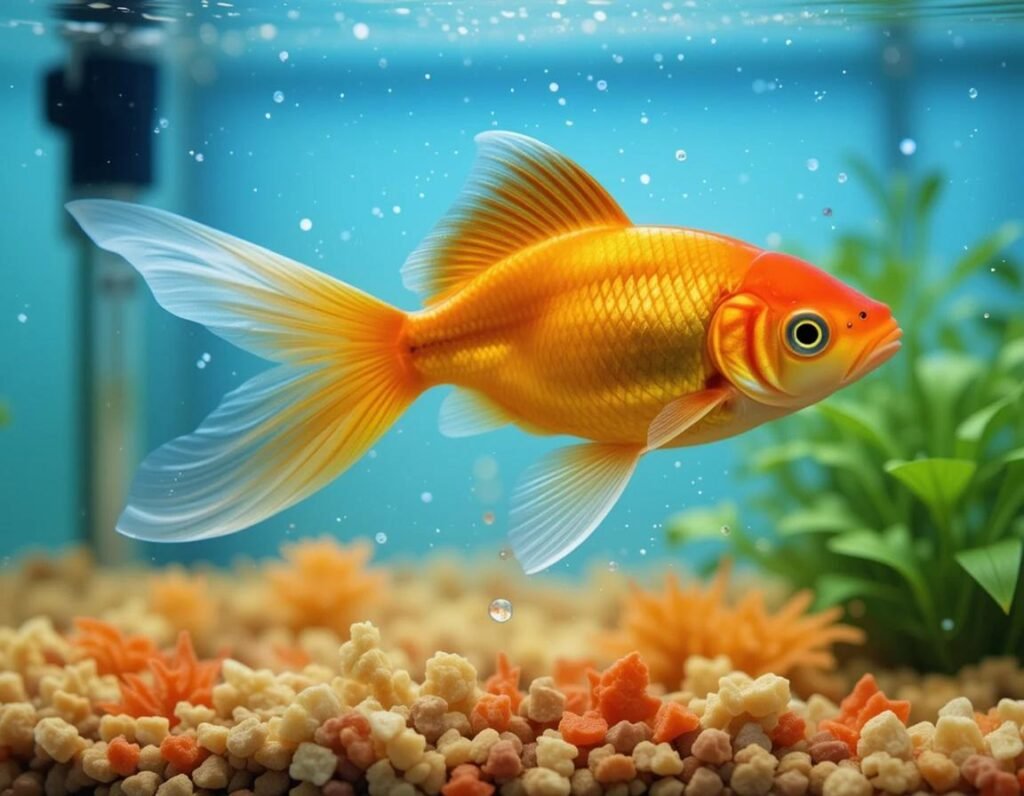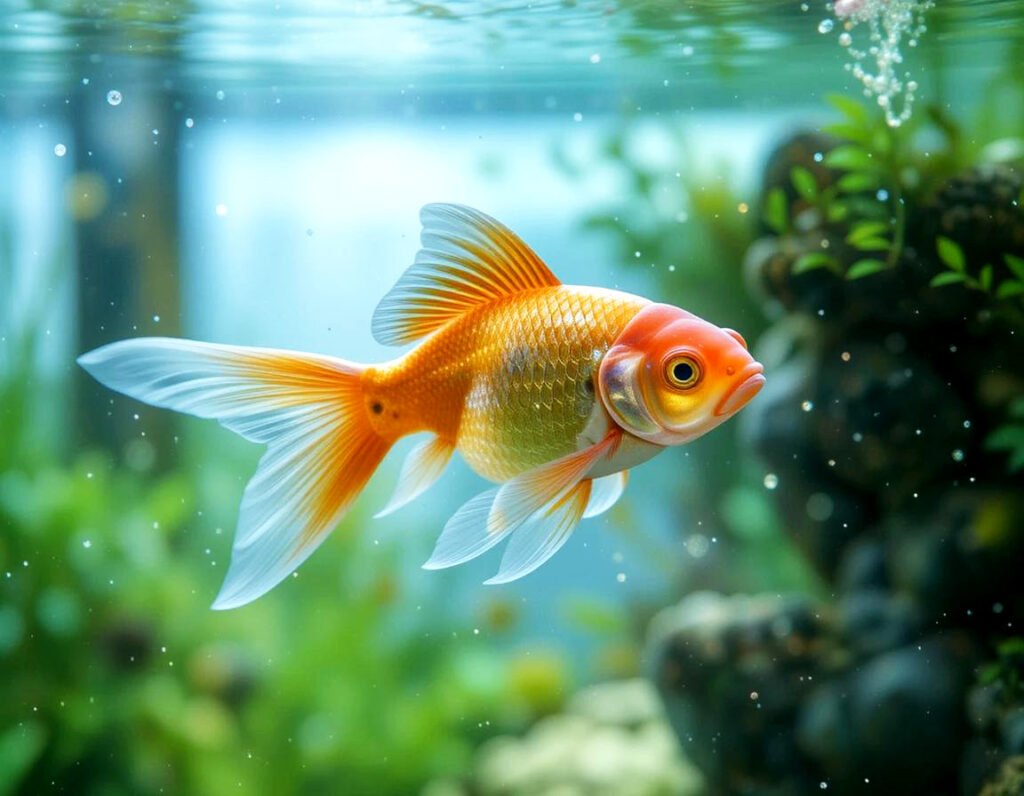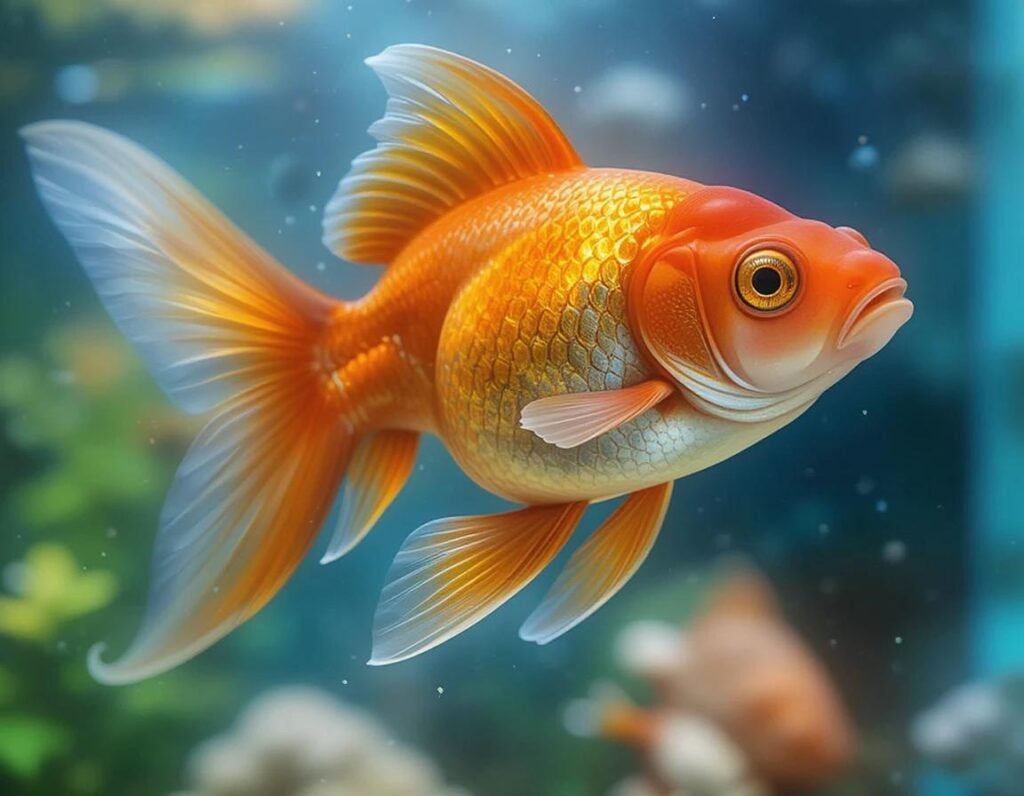
Goldfish Food Types: What to Feed Your Finned Friend for a Happy Belly
Goldfish are among the most popular pet fish out there, known for their bright colors and curious personalities. But just like any other pet, they need the right kind of food to stay healthy and happy. If you’re a new goldfish owner (or just looking to level up your fish feeding game), understanding the different goldfish food types is key to making sure your fish is living its best life.
In this guide, we’ll take a look at the main types of goldfish food, what they do, and which one is right for your fishy friend. Let’s dive right in—because your goldfish isn’t the only one that likes a good meal!
1. Goldfish Flakes: The Classic Favorite
Let’s start with the most common option: goldfish flakes. These are the ones you probably saw at your local pet store, and they’ve been a staple in goldfish diets for decades.
Goldfish flakes are great because they’re easy to use and typically come in a variety of flavors. From tropical blends to vegetable-based flakes, you can pick the one that suits your goldfish’s tastes. Plus, flakes float on the surface, making it easy for your goldfish to nibble away.
But here’s the catch (no pun intended): since flakes are lightweight, they can quickly break apart and cause water pollution if your goldfish doesn’t finish them. It’s kind of like throwing a few cookies on the floor and watching your dog eat them—except with fish, and no crumbs on the carpet!
2. Goldfish Pellets: The Substantial Snack
If you want to up your goldfish’s dining experience, pellets are the way to go. They are more substantial than flakes, so your goldfish will feel like it’s getting a hearty meal. Pellets come in sinking or floating varieties. The floating ones are great if you want to watch your goldfish take a bite and swim off in search of its next adventure. The sinking ones are for goldfish that prefer to hunt at the bottom of the tank like tiny underwater detectives.
Pellets are also nutritionally balanced, so they offer a full range of vitamins and minerals that your goldfish needs to thrive. However, don’t overdo it—just like we don’t want to overfeed ourselves at a buffet, goldfish can get a little too chubby if you go heavy on the pellets.
3. Goldfish Gel Food: The Fancy Feast
If your goldfish has an elite palate, gel food might be the best option. This type of food comes in a gel form that you mix with water and can either feed it as a whole or break it into small pieces. It’s packed with nutrients and can be tailored to include everything your goldfish needs for a well-rounded diet.
Goldfish gel food is like the gourmet meal of the fish world—think of it as the difference between boxed mac and cheese and a Michelin-star dinner. Your goldfish will appreciate the variety and the rich texture. Plus, gel food is easier on the water quality than flakes and pellets, since it doesn’t break apart as easily.
4. Freeze-Dried Food: The Crunchy Delights
Next up, we have freeze-dried food—think of it as goldfish snacks that are, well, kind of like jerky for your fish. These come in forms like freeze-dried worms, brine shrimp, and bloodworms. Goldfish love the added variety, and you can use freeze-dried food as an occasional treat or supplement to their regular diet.
Here’s the thing, though: while freeze-dried food is tasty and exciting, it can sink quickly and cause some water pollution. If your goldfish doesn’t eat it right away, it could get messy (and not in the fun, “accidental cereal spill” way). So, always remove any uneaten food within a few minutes to keep the tank from turning into a fishy swamp.
5. Live Food: The Ultimate Goldfish Snack
Okay, if you want to go all out and truly spoil your goldfish, you can consider live food. Goldfish, like their wild ancestors, love to chase after live snacks. You can feed them live brine shrimp, daphnia, or water fleas. It’s like having a goldfish dinner party where they’re the ones doing the hunting (minus the stress of watching your guests fight over the last shrimp).
Live food is packed with nutrients, but be careful—it’s best used as an occasional treat. And make sure you get your live food from a reliable source to avoid introducing parasites or diseases into your tank. After all, you want your goldfish to be the star of the show, not the next episode of a survival documentary.

6. Vegetables and Fruits: For the Health-Conscious Goldfish
Surprise! Your goldfish isn’t just about protein. It can also enjoy a healthy vegetable or fruit snack. Offer it blanched peas, spinach, or even slices of cucumber. These healthy treats are not only delicious but also help with digestion. You might even catch your goldfish nibbling on the veggies like it’s attending a salad bar. If only they could pay for their meal!
Just remember, when feeding veggies or fruits, remove any uneaten pieces promptly, as they can decay quickly and affect water quality.
7. The Importance of Moderation: Don’t Overfeed Your Goldfish
One of the biggest mistakes new goldfish owners make is overfeeding. Yes, those sad, puppy-dog eyes your goldfish gives you as it waits for another serving are seriously persuasive, but you’ve got to resist the temptation. Overfeeding can lead to obesity, water pollution, and even health problems like swim bladder disorder.
So how do you know if you’re overfeeding? A good rule of thumb is to feed your goldfish only as much as they can eat in about 2-3 minutes. If the food starts floating around in the tank long after that, it’s time to pull out the leftovers—just like when you leave pizza crusts on your plate (yes, your goldfish deserves better than pizza crust).
8. How to Choose the Best Goldfish Food for Your Pet
Choosing the right food for your goldfish can be a bit tricky, but don’t worry, it’s easier than choosing your favorite snack. Here’s a quick breakdown to help you choose the best option:
- Flakes: Great for quick feedings and easy to store, but may not be as nutritious for long-term use.
- Pellets: Offer more nutritional balance and are ideal for keeping your goldfish healthy.
- Gel Food: The premium choice, but it can be a bit fancier and pricier—perfect for goldfish with sophisticated tastes.
- Freeze-Dried: A fun treat that adds variety to the diet, but it’s not a meal replacement.
- Live Food: Ideal for adding excitement and nutritional boost, but use in moderation.
- Vegetables and Fruits: They’re nature’s candy, full of fiber, vitamins, and minerals!
Ultimately, you’ll want to rotate your goldfish’s food to keep things interesting (for both you and your goldfish). A healthy diet is about variety—so feel free to mix it up with different types of food throughout the week. Your goldfish won’t complain, and you’ll feel like the gourmet chef of the fish world.
9. Avoiding Common Goldfish Feeding Mistakes
Even the most well-intentioned goldfish owner can make a few mistakes. Here are some of the most common ones—and how to avoid them:
- Feeding human food: Goldfish can’t enjoy that leftover spaghetti or breadcrumbs like we do. Stick to fish-specific food to avoid digestive issues.
- Not varying the diet: Just like humans, goldfish need variety. A steady diet of only flakes or pellets can get boring for them.
- Ignoring water quality: Even if you’re feeding your goldfish the best food, poor water quality can cause health problems. Keep the tank clean and the water filtered.
- Giving too much food: We’ve already covered this, but it bears repeating. Less is more when it comes to goldfish food!
By staying on top of their diet and offering a balanced variety, you’ll avoid most of these common pitfalls. Your goldfish will thank you with vibrant colors and energetic swimming.
10. Final Thoughts: Feeding Your Goldfish with Love
Feeding your goldfish isn’t just about providing the right food—it’s also about offering it with love. If your goldfish looks happy and healthy, you know you’re doing something right. So, next time you see those big, curious eyes staring up at you from the tank, remember to feed it well and keep things balanced.
And hey, don’t forget to toss in a few treats from time to time—just don’t get carried away. After all, a goldfish with a well-fed belly and plenty of variety is the happiest swimmer in the tank. Who knows, maybe they’ll even do a little dance to thank you for the good grub!
Conclusion: Feeding Your Goldfish Right
So there you have it, folks—a rundown of the best goldfish food types to keep your finned friend swimming happily and healthily. From classic flakes to gourmet gel food, there’s something for every goldfish out there.
As long as you feed your goldfish a balanced diet (with a bit of variety and the occasional treat), your fish will be swimming in happiness. Just don’t forget to avoid overfeeding—because a chubby goldfish is a grumpy goldfish!
FAQs About Goldfish Food Types
1. What is the best type of food for goldfish?
Answer: The best food for your goldfish depends on their age and health. Pellets are highly recommended for their balanced nutrition and ease of use. They come in both floating and sinking varieties, which can be good for different types of goldfish. For a more gourmet option, gel food offers a highly nutritious choice. For variety and occasional treats, you can offer freeze-dried food, vegetables, or live food.
2. Can goldfish eat regular fish food?
Answer: Goldfish should not eat food designed for other types of fish. While it might seem tempting to use general fish food, goldfish have specific dietary needs that are best met with food designed for them, like goldfish flakes, pellets, or gel food.
3. How often should I feed my goldfish?
Answer: You should feed your goldfish 2-3 times a day, giving them only as much food as they can eat in about 2-3 minutes. Overfeeding can lead to water pollution and health issues. If you notice leftover food floating around, it’s time to cut back a little on the portions.
4. Can I feed my goldfish vegetables?
Answer: Yes! Goldfish can enjoy a variety of vegetables like blanched peas, spinach, and cucumber. These snacks provide extra fiber and nutrients. Just be sure to remove any uneaten pieces after a couple of hours to prevent them from decomposing and affecting water quality.
5. Can goldfish eat fruit?
Answer: Goldfish can occasionally eat fruit, but it should be given in moderation. Small pieces of fruits like apple or melon can be a tasty treat, but don’t overdo it. Avoid citrus fruits like oranges, as they can be too acidic for goldfish.

6. Is freeze-dried food good for goldfish?
Answer: Freeze-dried food is an excellent occasional treat for your goldfish. It’s packed with protein and can include items like brine shrimp or bloodworms. However, it can sink quickly and cause water pollution if not eaten right away, so be sure to remove any leftover food to maintain water quality.
7. How do I know if I’m feeding my goldfish too much?
Answer: If your goldfish is not eating all the food within a few minutes, you’re likely feeding it too much. Uneaten food can quickly pollute the water, leading to unhealthy tank conditions. A good rule of thumb is to only feed your goldfish as much as it can consume in 2-3 minutes.
8. What’s the difference between flakes and pellets for goldfish?
Answer: Flakes are lightweight and float on the surface, making them easy for goldfish to nibble on, but they can break apart quickly, causing water pollution if not eaten fast enough. Pellets, on the other hand, are more substantial and typically have a more nutritionally balanced formula. Pellets come in floating or sinking types, which allows you to cater to your goldfish’s feeding preferences.
9. Can I feed my goldfish live food?
Answer: Yes, goldfish love live food such as brine shrimp or daphnia. Live food provides a fun feeding experience and additional nutritional value. However, live food should be used sparingly to avoid introducing harmful bacteria or parasites into the tank.
10. How do I choose the best goldfish food for my pet?
Answer: When choosing goldfish food, look for options that are high in protein, fiber, and essential vitamins. Goldfish pellets and flakes are great for everyday feeding. Gel food is a premium option for a balanced diet, and freeze-dried food or live food can be used as occasional treats. It’s important to rotate their food for variety and ensure they get a balanced diet.
11. Should I feed my goldfish the same food every day?
Answer: It’s best to mix up the diet to keep things interesting for your goldfish. Offer a combination of flakes, pellets, and vegetables throughout the week. You can use freeze-dried food or live food as treats, but remember not to overfeed.
12. Can I feed my goldfish human food?
Answer: While goldfish are hardy eaters, it’s not recommended to feed them human food like bread, chips, or cooked meat. Stick to specially designed goldfish food to ensure they get the right nutrients.
13. How long can goldfish go without food?
Answer: Goldfish can survive for up to 2-3 days without food, though it’s not ideal to leave them hungry for that long. If you’re going away, consider using an automatic fish feeder or ask someone to feed your goldfish while you’re gone.
14. Can I make homemade goldfish food?
Answer: Yes, you can make homemade food for your goldfish, but it requires careful research and planning to ensure it’s nutritionally balanced. You could prepare blended vegetables, gel-based foods, or even homemade fish pellets, but it’s generally easier to rely on store-bought goldfish food designed to meet their specific dietary needs.
15. Is it okay if my goldfish only eats one type of food?
Answer: Goldfish are omnivores, meaning they thrive on a varied diet. If your goldfish is picky and only eats one type of food, try to offer other options in small amounts. A balanced diet helps keep your goldfish healthy and prevents nutritional deficiencies.


